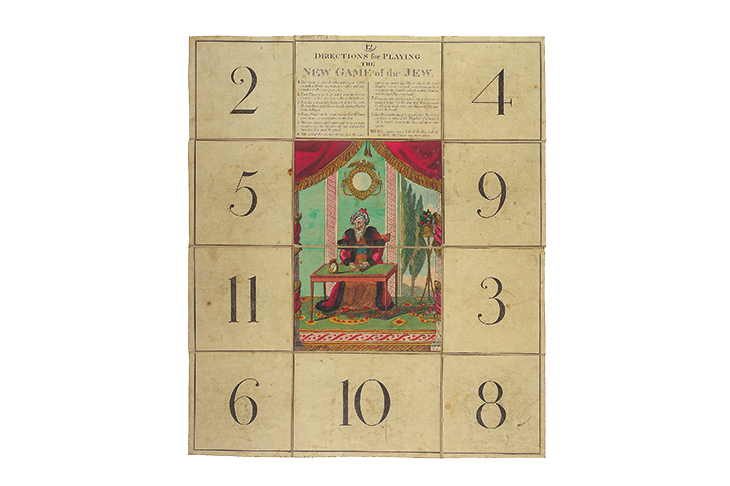Is now a good time to talk about Jews and money? The Jewish Museum in London thinks so, and perhaps it is right. Motifs of Jewish financial chicanery that have never really gone away are back. The internet age has allowed memes about Rothschilds, rootless financiers and other thinly veiled claims of Jewish duplicity to thrive as they haven’t for several generations. A film at the start of this new exhibition at the museum in Camden gives some context, with clips of recent anti-Jewish statements from the likes of Louis Farrakhan and other conspiracy theorists. It also includes Donald Trump talking about ‘elites’ draining power from America, which strikes me as an unfair overclaim about what the contents of this poisonous cauldron really are.
As the exhibition states, throughout history there have been rich Jews and poor Jews, but the claim that money is central to Jewish life has plagued Jewish people for at least two millennia. It is a claim largely borne of social and economic realities rather than the religion itself. For while the Jewish faith does indeed have a fair amount to say about the ethics of money, this stresses such things as charity, the system of tithes and so on, some of which is represented here by a set of antique purim plates used to collect charity on the festival day.
Soon we are into what for non-Jews is more familiar territory. There is the complicated impact of the Judas story and the motifs it embedded about Jews and money. These dark crossroads provide the opportunity for the artistic highlight of this show. Rather amazingly, for such a relatively small exhibition, a private collection has loaned one of Rembrandt’s earliest masterpieces, ‘Judas Returning the Thirty Pieces of Silver’, completed in 1629 when the artist was just 23. It is hard to think of anywhere you could spend an equivalent amount of time nearly alone with such a work.
In England the connection between Jews and money was embedded after the Norman Conquest, when the Catholic church regarded usury as sinful and some Jews took on the role of moneylenders. The link endured long after the expulsion of 1290, in characters such as Shylock, and received a boost in the mid to late 17th century when the first Jews to resettle in England were Sephardi merchants and bankers, attracted by London’s emerging status as the world’s financial centre. While Jews were recognised to be pedlars and paupers, it was the most successful Jews — Daniel de Castro, Moses Montefiore and Nathan Mayer Rothschild — who became most famous for their industry and accumulation of capital.
Here is a reminder of the old anti-Semitic problem — hatred of Jews can come from everything. From their wealth and poverty, for integrating and not integrating. This truth is well demonstrated here, with walls of 18th- and 19th-century caricatures ranging from the snobbish to the scatological. Kalen Ockerman’s mural in East London — which came to prominence last year after it remerged that Jeremy Corbyn had defended its Protocols-inspired contents — is included as a reminder of the persistence of the theme of the cunning, barely human, all-powerful Jew.
Ryan Gander’s 2019 work ‘I’m never coming back to Paris again’ adds a brilliant touch to these rooms. A pipe-sized hole in the gallery’s wall has a Swiss franc note stuffed into it, which goes in and out, with a rustling noise as though a mouse or rat is gnawing at it. It is a reminder, still audible in the last rooms on modern stereotypes, of the deep psychological wells that anti-Semitism draws upon. Something is always to blame. Someone is always keeping us down. How relieved people are to identify it.
If there were any need to prove this ubiquity it comes in the wall of posters from communist and fascist regimes that meet always, and everywhere, in an obsession with the Jews. One of the smallest, but most striking pieces in the whole exhibition is a 1,000-mark note from Weimar Germany (c.1924). In translation, the writing overprinted on the note’s front reads ‘The Jew took silver, gold, and bacon. He left us Germans with this shit.’
If there is a complaint to be made about this ambitious show it is that it finally ever so slightly skirts around the depth of the issue. The last room brings us back to the modern day and specifically to claims against George Soros. While there are plenty of people who disgracefully, and doubtless cynically, exaggerate the Hungarian-born billionaire’s significance, nevertheless he has attempted to exercise considerable influence over a number of countries, including Israel. And this is the problem with the whole question of Jews and money. The cauldron continues to bubble not because there is nothing to put into it, but because tiny portions of truth do go into it and can then be stirred into familiar poisons by fanatics of every stripe. A bolder exhibition would have gone right to the bottom of this conundrum. But the organisers should be congratulated for heading into it at all.
Got something to add? Join the discussion and comment below.
Get 10 issues for just $10
Subscribe to The Spectator Australia today for the next 10 magazine issues, plus full online access, for just $10.
You might disagree with half of it, but you’ll enjoy reading all of it. Try your first month for free, then just $2 a week for the remainder of your first year.















Comments
Don't miss out
Join the conversation with other Spectator Australia readers. Subscribe to leave a comment.
SUBSCRIBEAlready a subscriber? Log in